Ceiling tiles eventually require cosmetic repairs in the form of painting, even if they are of good quality. You can paint the foam plastic ceiling tiles immediately after finishing, or you can do it due to a change in the initial color during operation.
The need to paint ceiling tiles
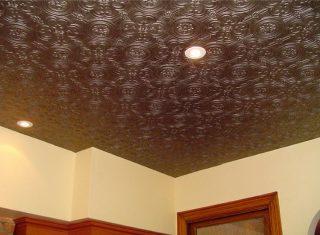
Initially, the ceiling panels have a snow-white color, but over time, yellowness appears, especially such changes are characteristic of the kitchen, where there is soot. Sometimes, immediately after installation, glue stains and fingerprints remain on the surface. These cases are the reason for painting foam ceiling tiles.
The coating material belongs to moisture resistant materials, so in the bathroom it does not collapse from condensation and water splashes. But when the drops dry, they leave streaks that turn gray and spoil the appearance of the ceiling. Therefore, the tiles in the bathroom should be painted to update, refresh the look of the room.
In the interior of living rooms, the ceiling is often made not white, but using beige, yellow, blue shades to match the walls. For color painting, the compositions are pigmented with special pastes, which are designed for water-dispersion compositions. After staining, the care does not change - the surface is also washed with soapy water using a soft cloth.
Types of paints
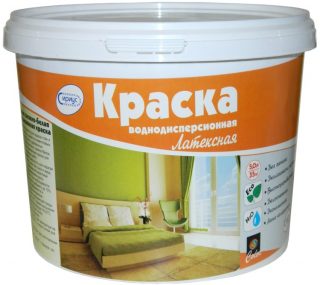
Not all formulations come into contact with the material without damage. Many paint components dissolve, soften and deform the foam. Do not use solvent-based products: white spirit, solvent, acetone. The tile can be coated with oil compositions based on drying oil, but the component differs from the foam in its linear expansion, it is more static, therefore, a network of small cracks subsequently forms.
The use of paints and varnishes is allowed:
- acrylic;
- latex;
- water emulsion.
Washable paints are considered a versatile option. Most often, such compositions are used for ceilings and walls. They cover the surface with an even layer, do not create drops and streaks, and are distinguished by fast drying.
These three paints represent variants of water-dispersion products, the difference is manifested in the types of filler. They are suitable for interior use because they do not contain aggressive components.
Acrylic
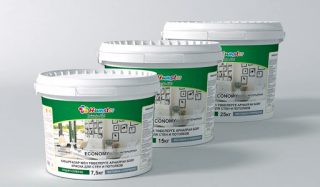
A kind of dispersion based on structural esters of cyanoacrylic, methacrylic acids (polyacrylates). Copolymers are used as surface film former. For work, the compositions are diluted with water, but after the appearance of the film, such surfaces are resistant to moisture. Such coatings are recommended for bathrooms and kitchens where there is a lot of steam.
Pigments are used to create a specific color. During operation, acrylic products do not emit harmful substances; after curing, they are also non-toxic.
Positive aspects of the application:
- do not have a pungent odor, dry quickly;
- the film belongs to the breathable layers;
- masks small irregularities;
- there is a large selection of dyes for mixing and ready-made colored formulations.
The surface of the foam can be painted several times (4 - 5), then the subsequent films will begin to flake off, so you will have to change the tiles on the ceiling. After drying, acrylic compositions acquire a darker shade, which must be taken into account when diluting the pigment on a white base.
Latex
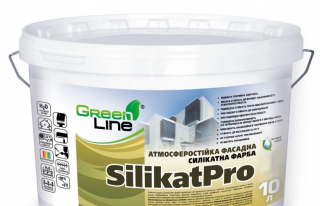
In such compositions, synthetic or organic latex is added, in addition to water, resins, pigment, which are included in a standard mixture for water-dispersion emulsions. A film on the surface is obtained after the evaporation of water particles, when the latex ingredients are combined with each other.
Positive qualities of latex coating:
- durable coating, gives strength against small blows (champagne corks);
- withstand aggressive washing with soap and water solutions;
- lack of unpleasant odor during work and operation;
- good indicators of the time of appearance of the film - 20 - 120 minutes;
- strong connection with foam.
Some latex compounds do not tolerate freezing temperatures; on verandas and balconies, products with certain characteristics are used, which are given in the description on the label.
The disadvantages include the significant cost of latex paints, while the price is higher than acrylic compositions, but cheaper than silicate ones.
Before applying latex, you need to treat the area with an antiseptic primer, since the coating can become a refuge for mold and mildew.
Water-based
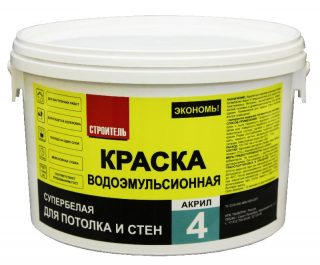
The composition contains water, crushed polymers, pigment. Particles are the basis, but do not dissolve in water, they are in suspension. Dissolve the paint with water, while you can add no more than 10%, otherwise you will get a transparent layer with poor hiding power, you need to paint it several times.
Antiseptics, antifreezes, thickeners, defoamers, plasticizers are also added to the composition. Enriched options are used in different environmental conditions. The number of modifiers is determined by the manufacturer, so all brands have distinctive properties.
Standard positive characteristics of the composition:
- cheaper than other analogues;
- does not leave streaks on the area of the ceiling tiles;
- safe for others;
- easily pigmented;
- does not fade and does not crack;
- protects against ultraviolet radiation, microbes, mold.
The lowered threshold of moisture resistance of water-based products does not allow painting the ceiling of foam tiles in the bathroom. Do not wash the surface, as the layer is washed off when using a soapy solution.
Paint selection rules
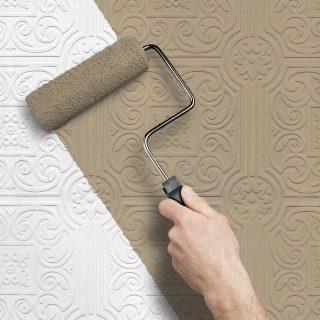
For coloring the foam on the ceiling, a glossy or matte variety is used. Matte is needed for a flat surface to hide flaws. The tile often has a convex pattern, so there is no fundamental difference in reflections or their absence. Ceilings are not washed as often as walls, for example, but the paint layer must withstand wet cleaning.
The ceiling is painted for a long time, so you need to choose high-quality material so as not to redo the work after a short time. For the kitchen and bath, a moisture-resistant latex variety is used or acrylic paints are used. For a bedroom, study, living room, a water-based coating is suitable. It cannot be washed with water, but it also does not get dirty as much as in the back rooms.
The color is chosen according to the preferences of the owner of the home, taking into account the color of the walls, the style of the room. Before work, you need to paint the tiles on the foam ceiling in a small area in order to see the final color when it dries (it may darken or lighten).
Required tools and materials

The surface is painted with a brush or roller.The tile has a relief on the surface, so you can use a brush without fear of getting bristle marks. It is better to use a roller with a long nap to reach into the recesses. If the relief is very convex, it is better to work with a spray gun. On the ceiling friezes, paint is applied with a brush, gluing the edges with masking tape before work.
Other tools needed:
- rubber spatula for preparatory work;
- foam sponge;
- a tray for paint with a wringing plane;
- stepladder or scaffold.
Of the materials, you will need deep penetration soil, it is better to take a concentrated one, which is diluted according to the instructions (more economical). The paint is taken at the rate of 120 g / m², this amount goes for 1 layer. The color composition is prepared so that it is enough for the entire area, since it will not be possible to repeat a similar shade if there is not enough paint.
For partial filling of flaws, a finishing putty is used. It is bred from dry powder or taken ready-made in small jars. The putty must dry before painting, then it is sanded with fine emery.
Preparatory work
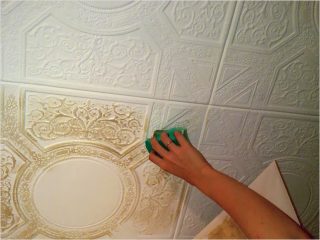
Most often, the ceiling is painted before finishing the walls and floors, so the splashes that fall on their surface are not particularly important. If the situation is different, the areas are protected from paint particles with polyethylene. Furniture is taken out of the room or also wrapped in foil.
If the tiles on the ceiling have just been laid, they are simply primed; for a used one, the preparation process is more complicated:
- degrease the surface, wipe dry;
- check the gluing so that there are no lagging areas;
- to increase the adhesion, the surface is lightly sanded with sandpaper;
- inspect the surface, and close up the existing cracks, cracks, after drying, they are treated with emery;
- primed with a roller or brush.
Putty using a rubber tool, since metal devices can make recesses in the body of the foam, which will also need to be processed. An acrylic based sealant works well for crevices.
DIY ceiling tile painting
When painting, the composition is evenly applied to the surface. You cannot save the composition by stretching it to adjacent areas - it is better to additionally dip a roller or brush. Excess paint will also not add beauty to the surface if drops appear on the patterned relief, which will dry out. Water-based, latex and acrylic paints are difficult to remove even from a flat surface, and it is almost impossible to do this on a convex ornament.
Subsequent layers are applied after the previous coatings have dried, otherwise the effect will be obtained as from applying one layer (the paint will mix). For the first layer, the composition is diluted with water. At the roller, the pile is cut off at the lateral edges so that during operation there are no stripes on the surface from excess paint that accumulate there.
After painting, drafts must be excluded so that the paint dries under natural moisture conditions.








